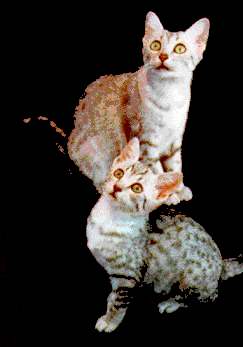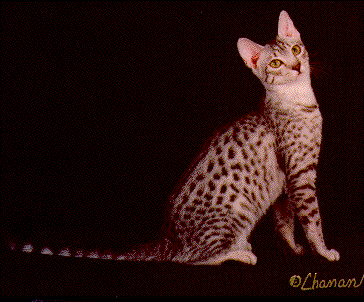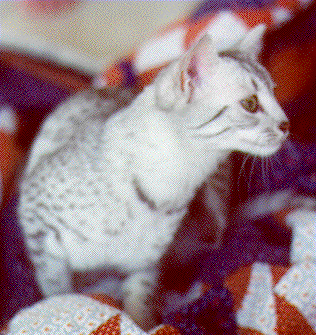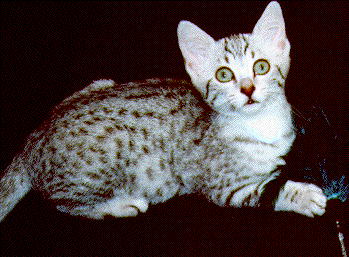

Mother and Daughter: Khepri and Comet...
"Who Is This Cat?
This... cat is Ra himself, and he was called 'Mau' because the speech of the god Sa, who said
concerning him: 'He is like (Mau) unto that which he hath made'; therefore did the name of Ra
become 'Mau'."
- (The Book of the Dead) 240BC The Papyrus of Ani translated by E.A. Wallis Budge
![]()
![]()
 In The Beginning...., or perhaps I should say,"Once upon a Time".... A
silver-haired, green-eyed monster came into our quiet home of three (my
husband David, myself and Tryst, our only child- a twelve year-old
Devon/Oriental cross) and turned our lives upside down. I had had cats my
entire life, David only for the past twelve years or so, but nothing in our
experience had prepared us for the utterly captivating, infuriating wonder of our
little silver Mau girl. It may be a cliché, but it is true. She stole our hearts and
never gave them back. Typical parents, we were convinced that she was the
most "incredible animal to grace this earth" (actually, truth be told, we still do - that's what is called
cattery blindness!). Imagine our chagrin, when after learning a little more about the breed, we
discovered that rather than being a precocious genius, she was merely representative of the breed. It
was a classic case of good news/bad news, though - that information opened innumerable vistas for
us! Vistas that we will undoubtedly continue to explore for the rest of our lives.
In The Beginning...., or perhaps I should say,"Once upon a Time".... A
silver-haired, green-eyed monster came into our quiet home of three (my
husband David, myself and Tryst, our only child- a twelve year-old
Devon/Oriental cross) and turned our lives upside down. I had had cats my
entire life, David only for the past twelve years or so, but nothing in our
experience had prepared us for the utterly captivating, infuriating wonder of our
little silver Mau girl. It may be a cliché, but it is true. She stole our hearts and
never gave them back. Typical parents, we were convinced that she was the
most "incredible animal to grace this earth" (actually, truth be told, we still do - that's what is called
cattery blindness!). Imagine our chagrin, when after learning a little more about the breed, we
discovered that rather than being a precocious genius, she was merely representative of the breed. It
was a classic case of good news/bad news, though - that information opened innumerable vistas for
us! Vistas that we will undoubtedly continue to explore for the rest of our lives.
To learn more about the exotic Egyptian Mau, scroll down to read more. To learn more about the Emau Cattery, click on the icon above.

CH Emau's Never Tease A Cheetah
Explore the Ancient World of the Egyptian Mau
- Legends and Mystery of the Egyptian Mau
- Ancient Origins
- The Mau in Their Rightful Place: Worshipped Deities
- The "Modern Mau"
- Appearance and Personality
Legends and Mystery of the Egyptian Mau
Ancient History, Ancient Myth... Legends and mystery surround the origins of this ancient and royal
 breed. Time itself has obscured the true ancestry of the modern day Egyptian
Mau, yet today, when a truly exceptional example of a Mau poses regally on a
judging table and gazes out at the world with its haunting imperious eyes, one
can truly envision these fabulous creatures gracing the halls of ancient Egyptian
temples.
breed. Time itself has obscured the true ancestry of the modern day Egyptian
Mau, yet today, when a truly exceptional example of a Mau poses regally on a
judging table and gazes out at the world with its haunting imperious eyes, one
can truly envision these fabulous creatures gracing the halls of ancient Egyptian
temples.
And grace them they did... The Egyptian Mau, the only naturally spotted breed of domestic cat, was
worshipped by its original owners, the ancient pharaohs and kings. The word Mau meant cat or sun
in Ancient Egypt and there is no question that the Egyptians revered the cat both as a god and as a
treasure. Papyri and frescoes dating back to as far as 1550 BC, depict spotted cats that look
extraordinarily like the Mau of today and have been found in abundance. The many documents found
from the dawn of the New Kingdom on make it very obvious that the cat was an integral part of daily
life as well as a worshipped deity in Ancient Egypt.
![]()
The actual domestication of the feline in Egypt, and indeed the world, probably coincided with the
advent of the silo in Egypt. With silos and all their accompanying benefits, came pests. With the
 pests, came predators. Rats and mice flourished and attracted such fierce
predators as the cobras and what was probably the African Wildcat (Felis
Silvestris Lybica). The process of domestication undoubtedly took
thousands of years, but the beginnings of the bond between man and cat
were forged as the Egyptians welcomed the superb hunting cats into their
lives. The strength of that relationship continued to build as the Egyptians
enticed the cats to join their households.
pests, came predators. Rats and mice flourished and attracted such fierce
predators as the cobras and what was probably the African Wildcat (Felis
Silvestris Lybica). The process of domestication undoubtedly took
thousands of years, but the beginnings of the bond between man and cat
were forged as the Egyptians welcomed the superb hunting cats into their
lives. The strength of that relationship continued to build as the Egyptians
enticed the cats to join their households.
It is hypothesized that most, if not all domestic cats, including the Mau,
originated in some way from Felis Silvestris Lybica, The African Wildcat,
and evolved through domestication and adaptation into the individual and
distinct breeds that we see today. The cats of ancient Egypt undoubtedly
can trace their origins to the African Wildcat. Although some theories do
postulate that the Mau is the domesticated descendants of Felis Lybica
Ocreata, which originated in Ethiopia and migrated from their to Egypt (Richard Davis- Two Time
Toby)
![]()
The Maus in Their Rightful Place: Worshipped Deities
The religious significance of the cat in Egypt predates recorded history. In the XIIth Dynasty (2800BC) the Egyptian Book of the Dead portrays the benevolent sun god, Ra, in the form of a spotted cat slaying the evil serpent of darkness.
The worship of the dual natured goddess, Bast, started out as a local cult and reached its zenith around 950BC when Bubastis, home of the cult of Bastet, became the capital of Egypt. The goddess Bast was depicted as a cat, representative of both the sun and the moon, which reflects the light of the sun. Although she primarily represented the moon, which reflects the life giving light and warmth of the sun in the darkness of night. She is also depicted as holding the serpent of darkness at bay with bloody tooth and claw and as such was referred to as the 'Tearer' or 'Renderer'.
Through the cult of Bast, the cat came to represent fertility, strength, and agility. It is most often depicted under the woman's chair in frescos and papyri. Paintings on the walls of the Pharaohs tombs often showed the spotted Maus on the laps and shoulders of their owners (much the same places you find them today). It is reported that family members showed their grief in losing a cat by shaving their eyebrows and the cats were prepared for burial in linens and fine jewels so that all could be rejoined in the afterlife. Tomb paintings depict the role of the family pet in ancient times. They are shown, bejeweled and pampered, on the laps and shoulders of their owners in domestic scenes. They are also shown as fishing and fowling companions in the papyrus marshes.
Legend has it that the Egyptians reverence for their Maus went so far as to cause them to lose a major battle with Cambyses II of Persia. According to legend, the Persians quickly realized that the Egyptians Achilles heel was their fanatical dedication to their cat and took many cats hostage. They then rode into battle holding the cats before them on their shields. Rather than risk killing or wounding the precious felines, the Egyptians surrendered the city of Pelusium (The Readers Digest Book of Cats page 30) The Mau was still held in reverence by the Egyptian people as late as Roman Times. In 1 BC the Sicilian historian Diodorus chronicles an incident where a Roman soldier stationed at Alexandra killed a cat. Although the Egyptians were in a delicate situation and would really have preferred not to antagonize the Romans at that point, there was no controlling the fury of the people. The soldier was seized by an angry mob and executed.
Further evidence of the high esteem given to the cat in Egyptian culture are the ornate and elaborate
sarcophagi that were used for cats in tombs... Mummies of cats complete with mummified mice
included in their tomb for food, have been found in the hundreds of thousands, many have been
found with fur intact. That fur was generally yellow (bronze in color) and exhibited spots, or in some
cases, stripes and spots. Despite the spotted fur found on mummified cats, there do seem to be two
"types of cats depicted in the ancient art work - spotted felines and a sandy colored cat. Both seem
to have the moderate body type that we see today in the Egyptian Mau. There is some speculation
that the little known and rather shy Jungle cat, Felis Chaus.., may have also been an ancestor of the
Mau and/or the Aby. Although the theory is not widely accepted, there is significant evidence that
suggests that both the Jungle cat and the African Wild Cat were held in captivity and it is likely that
there was some inter-breeding between these two. (Felines and Pharaohs). Regardless of the actual
origin, the cats that we find in the tombs do indeed bear a striking resemblance to our modern-day
Maus, lending credence to the theory that the Egyptian Mau is indeed one of the oldest, if not the
oldest, breed of domestic cat today.
![]()
Emau's El Shahab, DM - Comet
Traditionals - The origins of the Modern Mau in the United States lie with the exiled Russian Princess Nathalie Troubetskoy. The princess brought over three cats via Italy and started a breeding program here in the United States in the mid 1950's. Many, if not most, of the Maus that are seen in the U.S. today are direct descendants of two of those original cats that she brought over. The cats that come primarily from the Princess' lines have come to be called "Traditionals". Known mostly for their uncanny intelligence and exquisite head type, the traditionals have recently been mixed with what have come to be called the "Indian" lines to produce cats with gorgeous traditional heads and long and strong, 'typey' bodies with exceptional contrast and pattern.
CFA, the Cat Fanciers Association, accepted the Mau in 1977, and although the breed is still considered "very rare" the popularity has continued to grow.
 Imports - The "Indian Line" In 1980, Jean Mill
imported two cats, Toby and his sister, Tasha.
They were born in New Delhi, India. Both were
rufous bronze kittens with random spotting and
exhibited distinct Mau characteristics. In 1982, they
were registered with ACA. TICA accepted Toby's
line shortly thereafter although it took longer for
CFA to finally accept the new bloodlines, which
have been dubbed "Indian" lines. The introduction
of new blood effectively doubled the gene pool.
The expansion of the gene pool was sorely needed
as the severely limited gene pool of the traditional
Mau was starting to impact on litter size and
viability and the health and temperament of the cats
themselves. The expansion of the gene pool has had
Imports - The "Indian Line" In 1980, Jean Mill
imported two cats, Toby and his sister, Tasha.
They were born in New Delhi, India. Both were
rufous bronze kittens with random spotting and
exhibited distinct Mau characteristics. In 1982, they
were registered with ACA. TICA accepted Toby's
line shortly thereafter although it took longer for
CFA to finally accept the new bloodlines, which
have been dubbed "Indian" lines. The introduction
of new blood effectively doubled the gene pool.
The expansion of the gene pool was sorely needed
as the severely limited gene pool of the traditional
Mau was starting to impact on litter size and
viability and the health and temperament of the cats
themselves. The expansion of the gene pool has had
CH Matiki's Mia Cheetah of Emau, DM
several benefits that indicate that this minority breed which hovered on the point of extinction in the
80's is back on track and ready to expand into a new era. Over the past decade, we have seen litter
sizes increase, kitten viability improve significantly, and a decrease in the genetic problems that were
beginning to plague the breed when the gene pool was self-limiting.
![]()
A Unique Breed: Appearance and Personality
 Appearance - Walter Hutzler, a CFA judge, once
described the Mau in a final as "a primitive cat", and of all
the descriptors for these cats, that one seems to ring most
true in a rather obscure way... When you look at a Mau, or
catch sight of one out of the corner of your eye, they
should draw you back through the ages to something a
little exotic, a little "jungle", a little breath-taking and a little
"primitive". Make no mistake, these are heart-breakingly
beautiful cats. No picture or book can do justice to the
exotic beauty found in a silver Mau's dazzling green eyes
and shiny spots, the ghostly elegance found in a smoke
Mau's pattern, or the living room leopard grace of the
bronze. And no book, or photo can describe the way they
move. It's positively breathtaking. Watching them play
together, spots rolling into spots, is truly a sight to behold.
Appearance - Walter Hutzler, a CFA judge, once
described the Mau in a final as "a primitive cat", and of all
the descriptors for these cats, that one seems to ring most
true in a rather obscure way... When you look at a Mau, or
catch sight of one out of the corner of your eye, they
should draw you back through the ages to something a
little exotic, a little "jungle", a little breath-taking and a little
"primitive". Make no mistake, these are heart-breakingly
beautiful cats. No picture or book can do justice to the
exotic beauty found in a silver Mau's dazzling green eyes
and shiny spots, the ghostly elegance found in a smoke
Mau's pattern, or the living room leopard grace of the
bronze. And no book, or photo can describe the way they
move. It's positively breathtaking. Watching them play
together, spots rolling into spots, is truly a sight to behold.
Ch Pasha Khepri of Emau, DM- the Green-eyed Monster who stole our hearts...
If you've done any reading at all on this breed you know, of course, that they are the only naturally spotted breed of domestic cat. In terms of the breed standard, see the CFA home page for the full standard and as you read it remember that in all ways, the Mau is a moderate cat - they should neither be long and tubular like an Oriental, not short and stocky like a Burmese or American Shorthair. They are a lithe, muscular cat full of grace and beauty and the very way they move shouts "Athlete!". The infamous skin flap gives them extra latitude in jumping and they fancy themselves quite accomplished jumpers - they can flip and twirl in mid-air and really are quite impressive!
Colors - In CFA there are three acceptable show colors: Silver, Bronze and Smoke. The breakout is approximately 50%, 40%, 10%. Blacks have also been accepted for registration and use in the breeding program. As of June 1997, CFA has also approved the registration of the blue Mau.
Personality - All cats are characters, but these, well if you meet one you'll see... They are absolutely enchanting. We're a little subjective here, but we do not think that there is another breed out there to be found with such a lovable, infuriating and utterly captivating personality. Like all cats, they are individuals, one and all, but they tend to take it a step further than most. Friendly to all, they tend to select their "Special Person", who they absolutely dote on. On their own territory, however, they tend to be extremely outgoing with absolutely NO FEAR and a ton of curiosity... They make incredible companions.
They are shoulder riders, refrigerator vultures, and AM "kissers" (furry alarm clocks with warm raspy tongues..), but can take a confident hand when handling. Most Maus have very distinct ideas about who can handle them and when... They are sensitive, people-oriented cats, but they like things on THEIR terms! I like to consider "willfulness" a positive challenge versus a problem, but I like spunk and spirit and Maus have both in plentiful quantities. It is, I think, a quality about them that is important to know about, because in many ways it defines their personalities.
These are interactive cats. They dote on their humans and expect to be part of the family... That can come as a shock to those who expect the "typical" aloof" cat.
They really are phenomenally intelligent and as a result, easily trainable. They like challenges associated with training because it gives them something to work on... Our "first" girl, Khepri, a traditional silver queen, is leash-trained; so is her son, our alpha stud.
Toys are of utmost importance to nearly all Maus (every one I have ever met). They actually catalogue them and keep track of their whereabouts (don't try to put them up, they track them down and drive you crazy asking for them with their sweet trilling voices (most Maus have a lovely chirp rather than a typical Meow)...) Most Maus are very big into fetch (self taught, one and all) and will play forever....
As you may have heard, they are called "the gentle cousin of the Aby" and that may indeed be true. They can be great lap hounds (on their terms of course) and certainly aren't hyper hyper. On the other hand, some people say that they have the fastest reflexes of all the domestic cats (if you could see our girls going after their toys you'd see why). Judges' toys usually end up in Mau mouths and can sometimes be difficult to retrieve... Guess you could say that they have controlled energy...
People also say that they are one of the most intelligent breeds of domestic cats. I don't know about using absolute superlatives, but they are extremely smart. Some say too much so...
Let's see, what else is there to tell? For the most part, Maus generally get along extremely well with other animals, although they do tend to get a bit possessive about "their toys" and tend to try to establish dominance...
To learn more about the Emau Cattery, click on the Emau Cattery icon.
![]()
